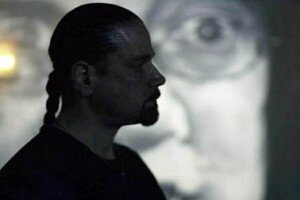Contemporary Artist, Richard Humann’s ‘Same River Twice’: Study in Accidental Fractals
By China Blue
2014
View of Richard Humann’s intallation work, ‘The Same River Twice, ‘ at CR10, Linlithgo, NY., 2013.
Considering information and concepts as fractal in nature, is a basis of mathematical analyses. Fractals are a tool for carrying out analysis of complex forms to reveal simple underlying structures. Yet exploring fractals in ideas and artwork, is an odd concept, until we consider fractals—not just as complex algorithms—but as ways to examine complexity. We can see this proposition in Richard Humann’s work “The Same River Twice,” shown at CR10, Linlithgo, NY, Summer 2013, by looking at how the work presents a visual representation of the natural form of the Hudson River, shaped by broken pieces of printed text. If the viewer contemplates the intersection formed in paintings of raw nature by the Hudson River School landscape painters, with Humann’s self-similar elements of text, cut out from printed books, screen plays and musical lyrics reorganized into the shape of the Hudson River, one can come to an understanding of a fractal way of looking at art, and “The Same River Twice.” artes fine arts magazine.
Artist, Richard Humann
The title of the work is based on the Heraclitus saying that, “No man ever steps in the same river twice.” Whether commenting on the physical flow of ever-changing water over the riverbed, or the more allegorical idea that the river of time can only be experienced once, Humann’s work examines both the physicality of the work and the conceptual idea of influences on his life—living on the edge of the Hudson River-parceled out in fragments. In considering the project, he understood that he can never go back completely to the past, despite remembering elements of it. Those influences which were once important, ideas, words and phrases, are now distorted and chaotically disordered by time and age, even though they continue to impact his life today.
The fractal is a powerful mathematical concept first described by mathematician Benoit Mandelbrot, in the mid 1970’s, helping to revolutionize how we understand our world. Roughness and self-similarity at multiple scales are the hallmarks of naturally-occurring fractals. The concept of self-similarity can be applied widely, ranging from fern fronds, whose axial leaf gets progressively larger, even as the “ragged” blade shape stays the same; to riverine watersheds, where “…every tributary has its own tributaries…so that it has the same organization as the entire river except that it covers a smaller area.” (McGraw-Hill Concise Encyclopedia of Science and Technology).
detail: Humann’s ‘The Same River Twice.’
Fractal Art is a form of computer generated art emerging in the 1980’s from the proliferation of relatively-powerful home computers. For the first time, computers enabled scientists, as well as the general populace, to explore and create fractal sets. The resulting images demonstrated the inherent power of mathematics to explain complex shapes, while overthrowing the common concept that mathematical solutions are simple and linear in form. However, in the 19th century, fractals were unrecognized. The Hudson River School painters of the 19th century were inspired by nature, uninformed by the fact that these natural forms were bound by mathematical principles.
Thomas Cole, The Course of Empire, the Savage State (1836).
Founded by Thomas Cole, and continued by artists like Frederic Edwin Church and Albert Bierstadt, among other New York landscape painters, this school was arguably one of the most significant to evolve in America. Inspired by the British aesthetic theory of the Sublime, these artists were in awe of the fearful and irregular forms found in the untamed wilderness (Nicolson, Marjorie Hope. Mountain Gloom and Mountain Glory. Ithaca, 1959). This idea rejected the idealization of nature and saw it for the beauty found in its’ dangerous, raw, and irregular characteristics. Ironically, the very ruggedness and self-similarity depicted in their painting of the mountains, rivers, or clouds provided epic and surprisingly fractal-like results.
detail: Humann’s, ‘The Same River Twice.’
The stylistic approach of a contemporary Hudson River artist, Richard Humann also had no intent to be fractal in nature, yet the reconfiguration of his memories to make the work, using chaotic ragged, and wild associations, evokes them as well. “The Same River Twice” consists of tens of thousands of words individually cut from books (right), all of which inspired him as a youth, living in Stony Point, a small town along the Hudson River. Forty miles and thirty years later, in New York City, he looked back and “dissected” the works. He “gathered the writings … The Brothers Karamazov, The Sirens of Titan, Sweet Thursday, Gulliver’s Travels, Janson’s History of Art, as well as poems by e.e. cummings, and countless other works, including movie screenplays and song lyrics. I … dissected the text, (physically from the books) word-by-word”. (He calls the result “cut ups.”) These works, once filled with meaning- absorbed while gazing at the whirls and eddies of the Hudson River- are now a fragmented, fractal-line personal history.
View of the Hudson from the tower at artist, Frederic Edwin Church’s Persian-style estate, Olana, above the banks of the river.
Considering fractals as a method of approach of artistic creativity provides a path that prizes the rugged, personal and emotional edges of human experience, while integrating it with hidden underlying principles shaping the world around the artist and the viewer. Humann’s “The Same River Twice” is a fascinating example of emergent complexity from simple elements, the basis of fractal organization in art and the world around us.
Link to article:
https://artesmagazine.com/?p=15287






